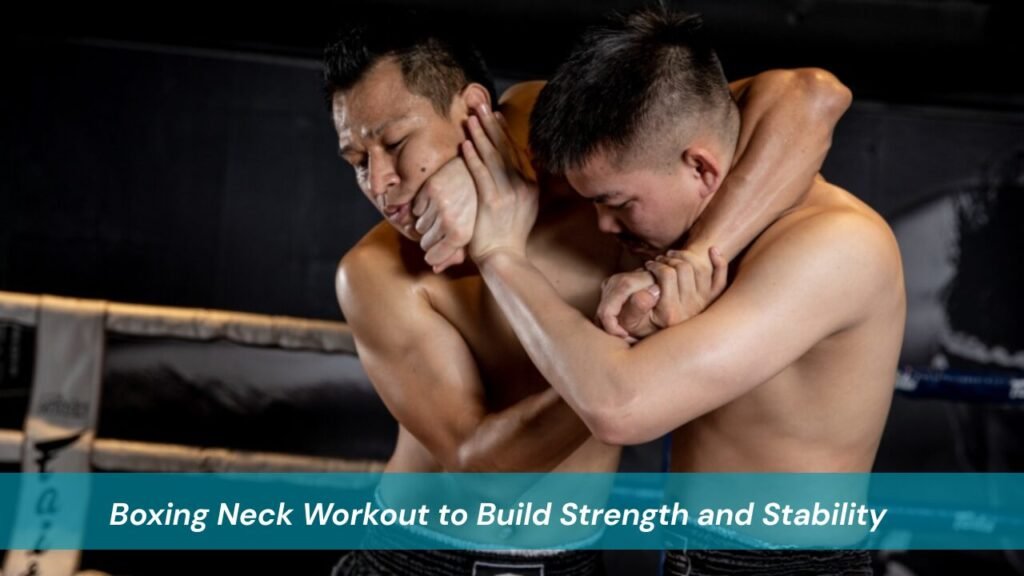Boxing is one of the most physically demanding sports, requiring a unique combination of speed, power, endurance, and mental toughness. While most athletes and fitness enthusiasts focus on punches, footwork, and conditioning, one of the most overlooked yet crucial areas of training is the neck. A well-developed neck is not just about appearance or muscle symmetry; it is a vital aspect of performance and protection. A structured boxing neck workout improves resistance to punches, enhances stability, reduces the risk of concussions, and builds overall athletic resilience.
In boxing, every punch that lands on the head generates impact forces that travel down through the neck and into the spine. Without proper strength and stability in this region, the body struggles to absorb and distribute the shock efficiently. Over time, this weakness can increase the risk of knockouts, neck strain, or even long-term injuries. This is why boxers at every level, from amateurs to world champions, dedicate time to building strong neck muscles. In this article, we will explore the importance of neck training in boxing, discuss the benefits, outline the most effective exercises, and provide practical ways to integrate neck workouts into your training routine.
Key Takeaways
- Strong neck muscles in boxing reduce risk of concussions and knockouts.
- Neck training enhances balance, posture, and overall athletic performance.
- Effective exercises include neck bridges, resistance band drills, and manual resistance.
- Consistent, controlled training 2–3 times per week ensures long-term neck strength and injury prevention.
Why Neck Strength is Crucial in Boxing
When most people think of boxing, they imagine punches, gloves, and fast footwork. However, what often goes unnoticed is how much strain the neck endures during every training session and fight. Each jab, cross, hook, or uppercut that lands on the head causes it to snap backward, forward, or sideways. If the neck muscles are weak, the head moves excessively, creating a greater risk of concussions or knockouts. Strong neck muscles act as natural shock absorbers, minimizing unnecessary movement of the head and protecting the brain.
In addition to injury prevention, a strong neck contributes to improved balance and posture. In the heat of sparring or competition, keeping your head steady helps you see openings, respond faster, and maintain defensive awareness. Proper posture allows for smoother breathing, better energy efficiency, and sharper movement. Even outside of the ring, the benefits extend to overall athletic performance, daily posture, and spinal health.
Another reason neck strength matters is psychological. Boxers who know their neck is well-trained often feel more confident in sparring or competition. They are less hesitant about taking punches and can focus more on strategy and execution rather than fear of injury. This mental edge, combined with physical resilience, creates a stronger overall fighter.
The Benefits of a Boxing Neck Workout
A dedicated boxing neck workout offers a variety of benefits that go beyond injury prevention. The most immediate and noticeable benefit is improved resistance to punches. Fighters with strong necks can withstand blows more effectively, reducing the likelihood of knockdowns. Strengthening the neck also reduces the risk of whiplash-like injuries, which often occur when the head is snapped back suddenly during a punch.
Another key advantage is improved posture and spinal alignment. Weak neck muscles often contribute to forward head posture, which not only looks unbalanced but also affects breathing and movement. Strong neck muscles counteract this by keeping the head upright, the spine aligned, and the body balanced. This stability translates into more efficient footwork, faster reaction times, and greater overall control in the ring.
In addition, a boxing neck workout enhances overall athletic ability. Stronger stabilizer muscles in the neck support movements across the shoulders and upper back, contributing to better body mechanics. This can improve punching power since force generation in boxing relies on a kinetic chain that starts at the feet, moves through the core, and finishes with the upper body. If the neck is weak, the chain is broken, but with a strong neck, the force flows more effectively.
For fitness enthusiasts who train in boxing for conditioning rather than competition, the benefits remain just as significant. Improved posture, reduced risk of everyday injuries, and greater overall stability make neck training an essential component of any well-rounded fitness routine.
Effective Exercises for a Boxing Neck Workout
Designing a proper boxing neck workout requires a balance between strength, stability, and mobility. While it is possible to train the neck with advanced equipment, most exercises can be performed with bodyweight, resistance bands, or light external resistance.
One of the most traditional and effective exercises for boxers is the neck bridge. This movement has been used for decades in both boxing and wrestling. To perform it, you lie on your back, lift your hips, and roll onto the crown of your head, supporting your weight with your feet and neck. Beginners can start with static holds, while advanced athletes can gently roll forward and backward. This exercise develops powerful stabilizers in the neck and builds resilience against impact.
Another excellent exercise is the resistance band neck extension. By attaching a band to a solid object and looping it around the back of your head, you can lean slightly forward and push against the band’s resistance. This strengthens the posterior neck muscles, which are especially important for resisting punches that push the head backward.
Neck flexion and extension drills also play an important role. Performed while lying on your back or face down with your head hanging off a bench, these movements strengthen the front and back of the neck. By slowly lowering and raising the head in each direction, the neck muscles are trained to stabilize against forward and backward forces.
To address side-to-side stability, side neck raises can be performed. By lying on your side with your head hanging off a bench and lifting it toward your shoulder, the lateral neck muscles are targeted. These muscles are critical for preventing excessive side-to-side head movement when punches land from angles.
Manual resistance drills with a partner are also effective, especially for fighters preparing for competition. A partner applies gentle pressure on different areas of the head while the athlete resists, mimicking the unpredictable forces encountered in the ring. This type of training not only builds strength but also conditions the neck to respond in a more fight-specific manner.
A Sample Boxing Neck Workout Routine
A beginner-friendly routine can be structured in a way that balances all areas of the neck. For example, you might start with neck bridges, holding each position for around fifteen to twenty seconds and repeating for three sets. Next, you could perform resistance band extensions for three sets of twelve to fifteen controlled repetitions. Following this, neck flexion and extension drills could be added, with three sets of twelve repetitions each. To complete the session, side neck raises and manual resistance drills can be included, ensuring all directions of movement are trained.
This workout does not need to be performed daily. Training the neck two to three times per week is usually sufficient, allowing the muscles time to recover. Over time, as strength and endurance improve, athletes can increase duration, resistance, or number of sets.
Safety Considerations in Neck Training
Because the neck is a sensitive area of the body, caution is essential when performing a boxing neck workout. Unlike larger muscle groups such as the legs or chest, the neck muscles are smaller and more prone to strain if overworked. For this reason, it is always recommended to start with lighter resistance and shorter durations before progressing to advanced levels.
Proper warm-up is equally important. Gentle stretches and rotations can prepare the muscles for training. Movements should always be slow, controlled, and never jerky. If pain or discomfort arises, exercises should be stopped immediately. Using correct form and focusing on quality over quantity ensures long-term progress without unnecessary risk.
Real-World Example
Professional boxers like Canelo Álvarez and Tyson Fury include dedicated neck workouts in their training regimens. Their routines incorporate neck bridges, resistance band exercises, and manual resistance drills to strengthen stabilizer muscles. This consistent neck conditioning helps them absorb punches more effectively, maintain balance under pressure, and minimize injury risk during high-stakes fights, demonstrating the real-world effectiveness of structured neck training.
How to Integrate Neck Training Into Boxing Sessions
Neck training does not need to dominate your workout schedule. Most athletes include it at the end of their boxing sessions, after heavy bag work, pad drills, and conditioning. This placement ensures the neck muscles are not fatigued during critical technical work. Alternatively, neck training can be added on conditioning days, allowing for dedicated focus.
Consistency is the most important factor. Just as you wouldn’t neglect core training or footwork, neck training should be seen as a regular part of your program. Over time, the benefits accumulate, and the improvements in performance, durability, and posture become obvious.
FAQs
Why is a boxing neck workout important?
A boxing neck workout is important because it strengthens the muscles that stabilize the head during impact. This reduces the risk of concussions, whiplash, and knockouts while improving posture and balance.
How often should I train my neck for boxing?
Most athletes benefit from training their neck two to three times per week. This frequency is enough to build strength without overtraining the smaller muscles of the neck.
Are neck bridges safe for beginners?
Yes, neck bridges can be safe for beginners if performed correctly. It is best to start with static holds rather than rolling movements and to progress gradually as strength improves.
Can I do boxing neck workouts at home?
Yes, many exercises such as resistance band drills, manual resistance, and bodyweight flexion or extension can be done at home without specialized equipment.
Do strong neck muscles prevent knockouts?
While no workout can completely prevent knockouts, strong neck muscles significantly reduce the chances by minimizing head movement during punches, making the fighter more resilient.
Conclusion
A boxing neck workout is one of the most valuable yet overlooked aspects of training. While punches, conditioning, and footwork often receive the spotlight, the neck plays a silent but vital role in protection and performance. Strengthening this area improves resistance to punches, reduces the risk of injuries, and enhances balance and posture.
Whether you are a professional fighter preparing for competition or a fitness enthusiast using boxing as a training method, integrating neck exercises into your routine can make a significant difference. With consistency, proper technique, and gradual progression, you can build a neck that not only supports your boxing skills but also protects your long-term health. In a sport where resilience and durability can mean the difference between victory and defeat, training the neck is not optional, it is essential.




